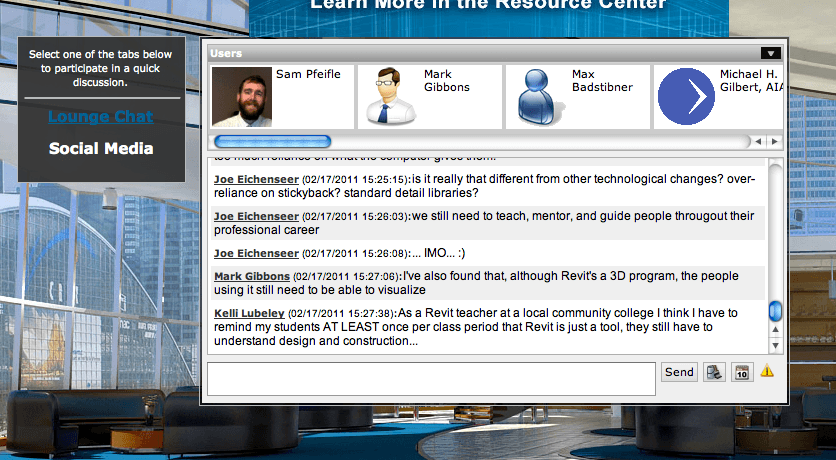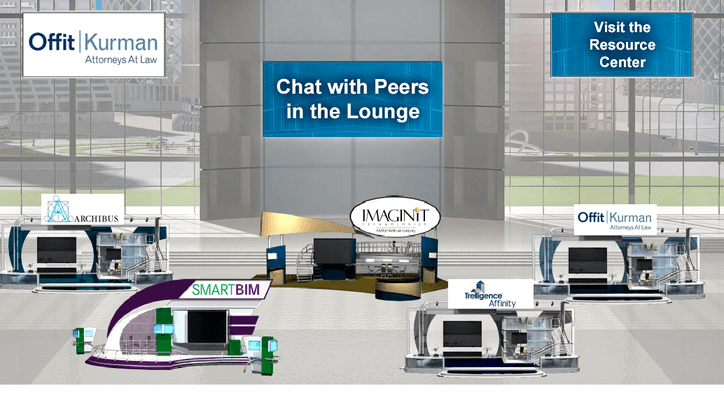Pretty cool event held today by IMAGINiT (I think that’s the right capitalization scheme…), a professional services organization working with architects and engineers who are using Revit and other Autodesk products. They put on today a virtual trade show of sorts all focused around BIM (that’d be building information modeling, just in case you’re new to this).
Called BIM 360, the event offered a virtual portal where attendees could chat with other attendees, view power point presentations and listen to presenters in a virtual theater (live and on demand), and visit trade show “booths,” where staffers were ready and willing to answer questions of all sorts. (I believe the on demand portion is good through May or so.)

For someone like myself, familiar with operating in online communities and a good and fast typist, it’s a pretty good experience. I’ll have a more newsy write-up of what went on in terms of content on the next newsletter, but suffice it to say that there was definitely content there worthy of consumption for the 3D professional. While much of the event focused on Revit and the new construction marketplace, there was definitely some good conversation and content surrounding scan-to-BIM.
For example, check out this back and forth that happened in the chat screen at the IMAGINiT booth:
Mark Gibbons (02/17/2011 14:40:13):Point clouds that I have seen have minor variations on the X,Y,Z locations of points in a line. For example, a wall that is straight up will have points that waver slightly in the X-Y axes. How does the software determine which points to use when locating a perfectly upright wall?
Beau Turner (02/17/2011 14:44:33):@Mark the scanner and software on the front end for registering is the first step to get this to be “clean” and a high definition laser scanner helps. In the Scan to BIM side we use associativity and clustering to help identify the location (and a few other items in the algorithm). We also use the “outline” and display to visually share with you what it found and allow you to adjust (the tolerances available allow you to fine tune this as well).
Joven Cavas (02/17/2011 14:45:45):hey Beau, stupid question here, are we talking about a “special” scanner???
Beau Turner (02/17/2011 14:46:53):hi Joven, there are several manufacturers of scanning hardware (that is the head unit that sits on top of the tripod) and vary in quality. I have more experience personally with the Leica ones but have been working some with FARO recently too.
Mark Gibbons (02/17/2011 14:47:51):Thank you for all the info, Beau!
Sam Pfeifle (02/17/2011 14:48:32):Hey @Mark – re: slight variations. That’s one of the difficulties with scan-to-BIM. The laser captures pretty close to exact reality, and most walls aren’t exactly straight when you scan them, considering fluctuations in the drywall, settling, etc. Taking point clouds and making them into models is sometimes as much art as science, for sure.
Beau Turner (02/17/2011 14:48:42):@Mark any time, if you want to talk more offline and/or share specific datasets/situations or if you see something missing that you need in the product feel free to contact me: [email protected]
Beau Turner (02/17/2011 14:51:36):@Sam is correct, we deal with two of the three situations: 1. Planar Walls, that is planar 90 degrees 2. Planar @ +/-, that is mass walls that go point to point with an angle between them. the third is showing all deformations, for that we currently have the distance feature and using documentation to address. This is an area that we are interested in doing more as well.

You can see that some substantive conversations can be had. However, what you’re not seeing are a couple of side conversations that I clipped out for the purposes of cutting and pasting here and you actually being able to follow it. One of the unfortunate parts of these virtual events is that the chat rooms get more hectic as more people show up. So, if only a few people are in the chat, you can have a conversation and make sense of it. If there are a bunch of people, the conversations get jumbled and it can cause people to bail.
Also, it’s hard to focus on these kinds of events because you’re sitting at your desk and your email is chiming in and your phone is ringing and people are coming over to your desk, etc. It’s really just a webinar with way, way more interaction, which is a good thing. It’s not a replacement for an in-person event, but it’s definitely a valuable tool both for the user coming to learn a thing or two and for the people putting it on, who grab some leads, have some conversations that show their knowledge, and hopefully generate both market understanding and some new business at the same time.





